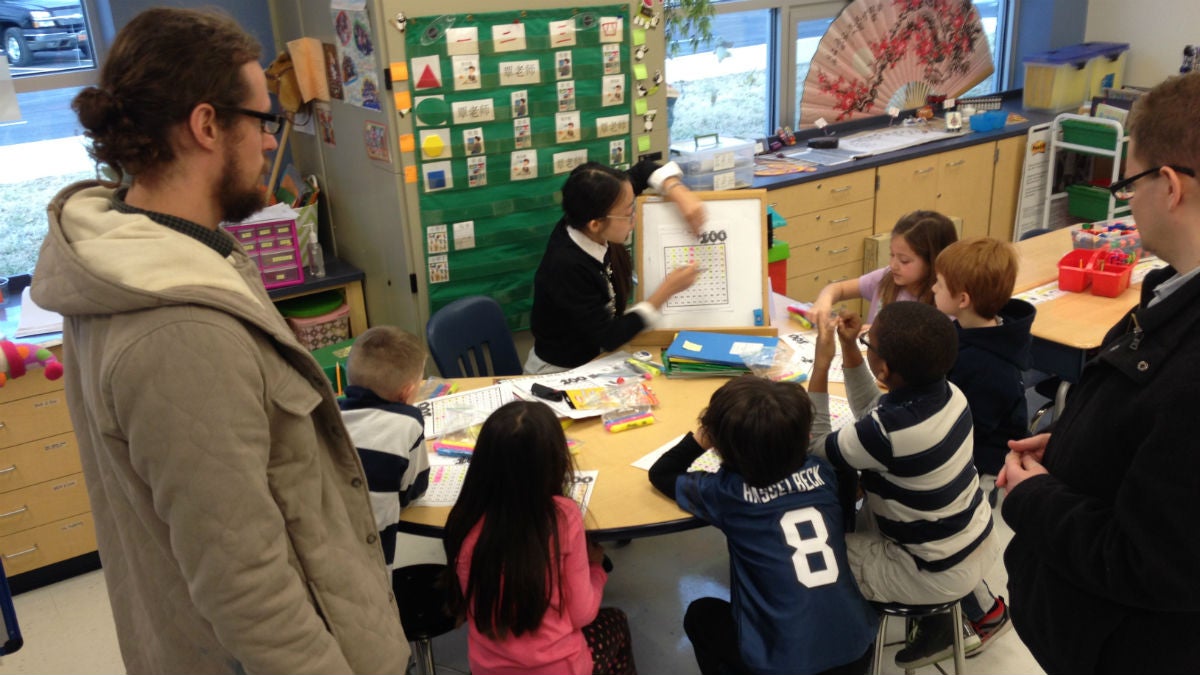In Delaware, looking for language teachers who ‘don’t really exist’
Listen
David Schultz (left) and Ben Tuck (right) observe a Chinese immersion class. (Avi Wolfman-Arent/NewsworksWHYY)
Delaware wants to grow its language immersion program. But finding teachers to staff it has proven challenging.
The Home2 Suites in Dover, Delaware isn’t exactly the Ritz, but it made a strong impression on David Schultz.
“I mean, teachers, We’re not used to this.” Schultz says, eyebrow arched.
“This” refers to five nights spent at a hotel chain that Wikipedia calls “mid-tier.” It also refers to a level of special treatment rarely afford to teachers—much less aspiring ones.
Schultz and three of his colleagues spent a week recently in Central Delaware as guests of the Delaware Department of Education. They’re all fluent in Mandarin Chinese. They’re all studying to be teachers at the University of Maryland. And they’re all willing to teach elementary school students, or at least consider it.
That rare combination makes them valuable—enough so that Delaware asked them up for a recruiting visit more than a year before they’ll be ready to teach.
“We want them to feel like this is the place they want to be,” says Gregory Fulkerson, who oversees world languages and international education at the Delaware Department of Education. “They want to be in Delaware. They want to live here. They want to work in our schools. They want to make sure our students are the best in the world.”
By 2020, nearly one tenth of Delaware’s public school students are expected to be in language immersion programs. That means about 10,000 students will spend half their day, every day learning in a foreign language. It’s one of the nation’s most ambitious immersion expansion plans. But to pull it off, the state needs dozens of specially qualified teachers.
To find them, it has scoured the globe. Indeed there may be no type of teacher more rare or sought after these days, than the immersion teacher.
A “counter-cultural” approach
Immersion education in the United States dates to the early 1970s. It is, in many respects, a rebel approach to teaching language. “I think it’s really important when you’re talking about immersion to keep in mind that a language immersion program is a counter-cultural, alternative model,” says Tara Fortune, the immersion program director at the University of Minnesota’s Center for Advanced Research on Language Acquisition.
Whereas most districts teach foreign education in middle and high school, immersion starts in the earliest grades. Delaware’s immersion students, for instance, begin as kindergarteners and continue through eighth grade.
They also learn subjects like math and science in the target language, an approach that, research suggests, is far more effective than teaching students through isolated, foreign language classes. There’s even data indicating that children in immersion learn English better than their non-immersed peers.
Racing to become “the most bilingual state”
Despite these benefits, language immersion has existed only in isolated pockets. But that’s changing as the economy changes. A country that once “suppressed” languages, in Fulkerson’s words, is starting to embrace them as it looks nervously toward a more globalized future.
Delaware Governor Jack Markell summarized the prevailing logic at a recent press conference. “The bottom line for me is when Spanish companies or companies from Latin America or Chinese companies are considering where in the United States to expand, I want Delaware to be at the top of the list,” Markell said. “We have a lot of things going for us in the state and I believe we can aspire to be the most bilingual state.”
Delaware and Utah are both amid major, statewide pushes to expand immersion education. New York City and Washington, D.C. are also looking to grow. After a decade-long plateau, the number of language immersion programs in the U.S. grew 70 percent between 2006 and 2011 according to the Center for Applied Linguistics.
“There’s this domino effect in place right now, which is if your neighbor starts increasing the number of potentially bilingual employees, then your state suddenly becomes more vulnerable,” says Fortune.
Supply and demand
Delaware started with three programs in 2012. This fall, that number will be 17. All this growth has placed a major strain on the already-slender supply of immersion teachers.
It’s already difficult to find language-proficient teachers in a country that is famously monolingual. A plurality of districts in Delaware, for instance, say foreign lanuage positions are the toughest to fill according to a 2013 “Supply & Demand” survey.
Those teachers that have the language skills tend to train as middle or high school instructors, since that’s where the bulk of jobs are. Few learn how to teach content in a foreign language, and few learn elementary school pedagogy.
“The staffing problem or the staffing challenge is decades old,” says Fortune. “Now that the programs are growing I think the greatest concern nationally is maintaining well-implemented programs. Because you cannot maintain well-implemented programs without highly skilled educators.”
“They don’t really exist”
The University of Minnesota is among a small handful of schools that offer an immersion certification for aspiring teachers. That number figures to grow, but until it does, states like Delaware must improvise.
“Finding immersion teachers is a challenge because there’s no university right now that’s just popping them out,” says Fulkerson. “They don’t really exist.”
Most of the state’s Spanish-language instructors, for instance, come direct from Spain. The state has an agreement with the Spanish education ministry that allows it to import elementary school teachers. State officials have also visited China four times to recruit teachers as part of a program sponsored by the College Board.
State officials say they’re happy with the foreign teachers they’ve received, but would prefer “domestically sourced” instructors, Fulkerson says. Teachers on visas, he explains, often have to return home, creating high turnover.
Incentives and improvisation
The state gives districts with immersion programs $10,000 per program per year for teacher recruitment and retention. Some districts spend the cash on signing bonuses or visa assistance, but union contracts limit their options.
In Delaware writ large, teacher salaries correspond solely to experience and degree-status. Some want to loosen those restrictions, but for now districts cannot entice teachers in high-need subjects with higher pay.
Demand, in other words, is high. Supply is low. Wiggle room for creating incentives is limited.Fulkerson knows, for instance, that the students he’s courting from the University of Maryland will have plenty of options when they graduate.
“Nationwide, if you’re a Chinese teacher, you won’t have a problem finding a job,” he says. “States like West Virginia, they can’t find Chinese teachers so they hire twenty-plus teachers from China every year to fill the need. North Carolina, Ohio, they’re all the same. There’s a hunger for Chinese teachers that they can’t find.”
Hustling
To lure the best teachers, Fulkerson and his staff have to hustle.
The state is spending a little under $4,000 to bring 10 teachers from the University of Maryland up to Delaware over their winter break. It’s also courting students from China that are learning how to teach English at the University of Delaware. The state thinks it can tempt some of those students to stay and teach Chinese instead.
In some cases, the state has eased certification standards for immersion teachers. Statewide, 91.8 percent of foreign language teachers are “highly qualified”—a label that means they have “full state certification for teaching the subject” and a bachelor’s degree. That’s the lowest percent of highly qualified teachers in any subject area. The number is partly attributable to the influx of immersion teachers, Fulkerson says, some of whom don’t meet the highest certification standards.
For the students from the University of Maryland, the state will work with them to make sure they pass the elementary school praxis exam. From there, it will try to mold them into immersion teachers.
Before that, though, state officials have to pique their interest.
“The best school I have ever visited”
On their first day in Delaware, the students bounce between Chinese immersion programs at three different schools. In a kindergarten class, students sing together in Mandarin. In a second-grade class, one student leads her peers in a math exercise.
It’s all very impressive, and the recruits seem suitably taken.
“I think here is the best school I have ever visited in America,” says Shao Yue, a Maryland student originally from Beijing. “It seems like they’re giving us the best—state of the art facilities,” says Schultz, a Maryland native. “There’s some really appealing things.”
None of them knows much about Delaware—“I just know we don’t have to pay tax,” Shao says—but they all seem open to a move after seeing the classrooms, meeting the teachers, and, of course, luxuriating in their temporary digs.
“The hotel here is really fancy,” Shao says. “And the people here are really nice.”
Correction: This article originally misidentified the University of Minnesota’s center on language learning. It is the Center for Advanced Research on Language Acquisition, not the Center for Advanced Research on Learning Acquisition.
WHYY is your source for fact-based, in-depth journalism and information. As a nonprofit organization, we rely on financial support from readers like you. Please give today.





